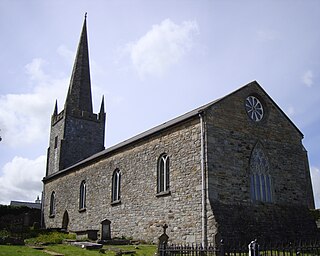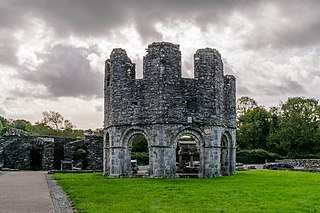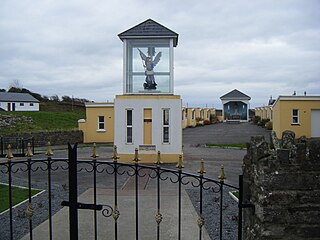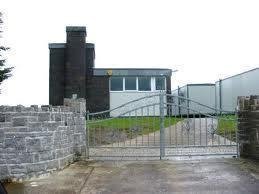
Kinvara or Kinvarra is a sea port village in the southwest of County Galway, Ireland. It is located in the civil parish of Kinvarradoorus in the north of the barony of Kiltartan. Kinvarra is also an electoral division.

Malachy is an Irish saint who was Archbishop of Armagh, to whom were attributed several miracles and an alleged vision of 112 popes later attributed to the apocryphal Prophecy of the Popes.

Killala is a village in County Mayo in Ireland, north of Ballina. The railway line from Dublin to Ballina once extended to Killala. To the west of Killala is the townland of Townsplots West, which contains a number of ancient forts. Historically associated with Saint Patrick, and the seat of an episcopal see for several centuries, evidence of Killala's ecclesiastical past include a 12th-century round tower and the 17th century Cathedral Church of St Patrick. As of the 2016 census of Ireland, the village had a population of 562. The village is in a civil parish of the same name.

Mayo or Mayo Abbey is a village in County Mayo, Ireland. Although it bears the same name as the county, it is not the county seat, which is Castlebar. Mayo Abbey is a small historic village in south Mayo approximately 16 km to the south of Castlebar and 10 km north west of Claremorris. The village is in a civil parish of the same name.

Kilglass or Kilglas is a rural townland in County Sligo, Ireland, in the hinterland of Enniscrone. Kilglass is in a civil parish of the same name.
Cellach of Armagh or Celsus or Celestinus (1080–1129) was Archbishop of Armagh and an important contributor to the reform of the Irish church in the twelfth century. He is venerated in the Roman Catholic Church as Saint Cellach. Though a member of the laicised ecclesiastical dynasty of Clann Sínaig, he took holy vows and gained priestly ordination. This put an end to the anomalous state of affairs, in effect since 966, whereby the supreme head of the Irish Church had been a layman. Following the Synod of Ráith Bressail, in which a diocesan structure for Ireland was established, he became the first metropolitan primate of all Ireland.

Glenamoy is a village in the civil parish of Kilcommon, Erris in the northern part of County Mayo in Ireland. The R314 road passes through Glenamoy.

The Bishop of Killala is an episcopal title which takes its name after the village of Killala in County Mayo, Ireland. In the Roman Catholic Church it remains a separate title, but in the Church of Ireland it has been united with other bishoprics.

The Synod of Kells took place in 1152, under the presidency of Giovanni Cardinal Paparoni, and continued the process begun at the Synod of Ráth Breasail (1111) of reforming the Irish church. The sessions were divided between the abbeys of Kells and Mellifont, and in later times the synod has been called the Synod of Kells-Mellifont and the Synod of Mellifont-Kells.

Kilcummin is a beachhead and civil parish on the northern coast of County Mayo in Ireland. Traditionally a fishing community, the Kilcummin area is sparsely populated. The "Tír Sáile - North Mayo Sculpture Trail" and "Tour d'Humbert" tourist route lead through the area. Kilcummin overlooks Killala Bay, the blue flag beach "An Trá nRoss", "Bartra Island" and lies on the opposite shore to Enniscrone and its beach in County Sligo.

Kilmihil is a village in the Barony of Clonderlaw, west County Clare, Ireland. It is also a civil parish and an ecclesiastical parish in the Roman Catholic Diocese of Killaloe. The area was officially classified as part of the West Clare Gaeltacht; an Irish-speaking community; until 1956.

Kilmovee is a village and civil parish in County Mayo, Ireland. It is a mainly rural parish on the R325 road, midway between Kilkelly and Ballaghaderreen.

Kilmacrennan, also Kilmacrenan, is a village, townland and civil parish in County Donegal, Ireland. The village population was 753, as of the 2016 census. The village's population has increased steadily over the last decade with many new housing developments catering, in particular, for an overspill population from Letterkenny. Kilmacrennan was historically the caput of its eponymous Barony of Kilmacrennan, of the eight Baronies of Donegal.
Kilbrin is a civil parish in the barony of Duhallow, County Cork, Ireland. Once an independent parish, Kilbrin is now joined to the parish of Ballyclough. Kilbrin derives its name from an early church site or monastery namely Cill Bhrain, i.e. the church of Saint Bran.
Gilla Críst Ua Mocháin was an Irish craftsman, fl. 1120s.

Killimer is a village in County Clare, Ireland, in a civil parish of the same name. It is located on the northern bank of the Shannon and the N67 which passes through the village.
Kilcurl comprises the two townland areas of Kilcurl Anglesey and Kilcurl Feronsby. The townlands are situated one mile (1.6 km) from its nearest village, Knocktopher, and located on a road to Carrickshock monument one mile (1.6 km) away and two miles (3.2 km) to Ballyhale. The village of Knocktopher is situated in the parish of Ballyhale, south County Kilkenny, in Ireland.

Shrule Abbey is a former monastery and National Monument located in County Mayo, Ireland.

Midfield is a village, in the barony of Gallen, in County Mayo, in Ireland. It is located close to the towns of Kilkelly, Kiltimagh, and Swinford, and to Ireland West (Knock) Airport.
Ballyagran is a village and townland in County Limerick, Ireland. As of the 2016 census, the village had a population of 179 people. Ballyagran is also the name of a half-parish in the Roman Catholic Diocese of Limerick.

















